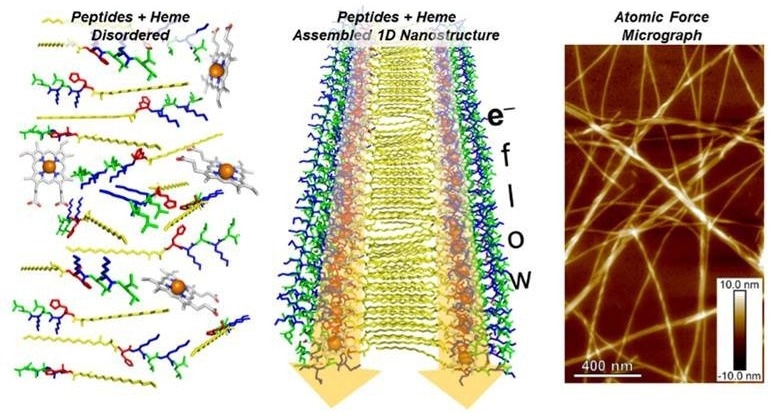Peptides are biological molecules essential to several biological processes, such as the movement of electrons and oxygen. The building blocks of proteins, amino acids, are arranged in short chains to form peptides. Additionally, they serve as an inspiration for novel biotechnologies. A synthetic version of a peptide that self-assembles into nanoscale threads that transmit electricity when coupled with heme is being developed by researchers.
 Peptide molecules and heme disordered in solution (left) are transformed into an ordered one-dimensional (1D) self-assembled nanostructure (center) that supports electron flow, as imaged by Atomic Force Microscopy (right). Image Credit: Argonne National Laboratory
Peptide molecules and heme disordered in solution (left) are transformed into an ordered one-dimensional (1D) self-assembled nanostructure (center) that supports electron flow, as imaged by Atomic Force Microscopy (right). Image Credit: Argonne National Laboratory
Heme is a material that naturally assists proteins in transporting electrons from one location to another. The researchers ascertained how the length and identity of the amino acid sequence of the peptide influenced the electrical conductivity of their peptide nanofibers.
The Impact
In nature, the structural properties of peptides affect their function and their potential for biotechnology. The length of the peptide segments that make up complete peptide chains is one of these factors. They also comprise the arrangement of certain amino acids in a peptide.
The findings of this study will aid researchers in creating peptide assemblies that create nanoscale fibers and transport electrons over long distances, potentially making these fibers helpful in medical devices, biosensors for various applications, and robotics.
They also show promise in the creation of novel enzymes, which are used by corporations to create and improve things such as medical-grade and household cleaning solutions.
Summary
Research on protein and peptide nanostructures in nature is conducted in the fields of materials science and biochemistry. There is a lot of potential for these nanostructures as bioelectronic materials. Creating a synthetic analog that can construct one-dimensional (1D) nanostructures would open up new avenues for material development and significantly advance the understanding of the natural system.
A group of peptides that self-assemble into one-dimensional layered nanostructures were studied by researchers at Argonne National Laboratory’s Center for Nanoscale Materials. The peptides PA-(Kx)n is simply referred to as PA-Kxn. In this case, x is the amino acid leucine (L), isoleucine (I), or phenylalanine (F), and PA is c16-AH with c16-A being modified alanine (A). H stands for histidine, K for lysine, and n is the length of the sequence repeat (1-4).
The group ascertained the effects of the hydrophobic amino acid and the length of the peptide sequence (n) on three important parameters: the electronic characteristics, the density of heme, and the heme’s binding affinity to pre-assembled peptides.
The sequence length of two sequences produced the highest binding affinity in the peptide assembly. The electroactive molecule heme was generated in ordered arrays by the ensuing nanoscale assemblies.
Except for PA-KL1, all of the peptides had nanofibers with a high aspect ratio independent of repeat unit length or sequence. Such structures have the potential to be used as supramolecular bioelectronic materials in biomedical sensing and enzymatic material creation.
The research at the Center for Nanoscale Materials, a DOE Office of Science user facility, was funded by the DOE Office of Science, Office of Basic Energy Sciences.
Journal Reference:
Fry, H. C., et al. (2023). Designing 1D multiheme peptide amphiphile assemblies reminiscent of natural systems. Nanoscale. doi:10.1039/d2nr00473a